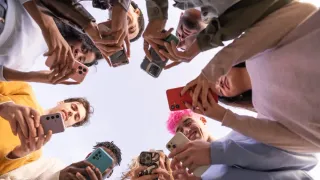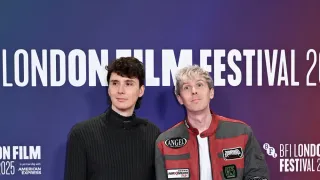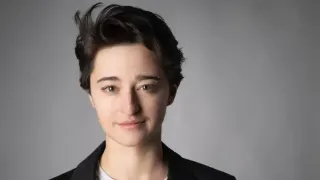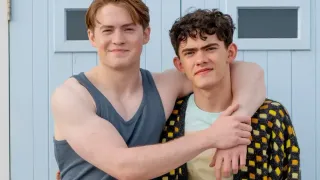May 30, 2023
The Wiz, Kids: Director Sam Pinkleton Rethinks Oz for the Stage
Jim Gladstone READ TIME: 5 MIN.
We're off to see...the movie?
That's the question that's been cycloning around my mind ever since last April, when American Conservatory Theater first announced its planned production of "The Wizard of Oz," now in previews with opening night June 7.
After all, though the long and winding yellow brick road technically began with L. Frank Baum's 1900 children's book, the Oz that has been definitively imprinted on the consciousness (and subconsciousness) of generations is the 1939 MGM movie musical starring Judy Garland. A broadcast staple beginning with the advent of color television in the 1950s, it turned even the smallest cathode ray set into an intracranial IMAX.
Indeed, Sam Pinkleton, the director of the A.CT. production, fell in love with the film when he was growing up in the small town of Hopewell, Virginia, "It's really the moviest of movies. It does everything that film is great at."
"I've never seen a stage production [of 'The Wizard of Oz']," said Pinkleton, "But, to me, the challenge is to honor the story and its themes by using everything that theater is great at doing, rather than trying to imitate what movies are great at. I wanted to make a stage version that makes you feel as thrilled with theater as the film makes you thrilled about movies."
"Even if A.C.T. had said to me, 'You can have a cast of 600 and an unlimited budget,' " said Pinkleton in an interview with the Bay Area Reporter at A.C.T.'s rehearsal studio, "it would be an unconscionable amount of time and human resources – and it still wouldn't be as good as the movie! But to try and recreate the movie on stage is a fool's errand."
An errand, as it happens, that fools have chosen to run. Pinkleton and company will be working with the same screenplay-derived script used in a massive, spectacle-laden cinema simulacrum first mounted by the Royal Shakespeare Company in 1987 and adapted into a touring arena show.
Here's the Associated Press on that production's 1989 engagement at Radio City Music Hall:
"The house is lifted by wires to a figure-eight dolly on the dome of the Music Hall, where it totters slowly...like a car on a Ferris wheel ... There is no brutal force – even the sound effects and lighting are limp." (Fun fact: That show's Dorothy, Grace Grieg, was discovered by its producers in the Las Vegas run of "Beach Blanket Babylon.")
A review in the Los Angeles Times was pithily headlined: "If it only had a heart."
To Oz? To Oz.
Intimacy, rather than imitation, is key to Pinkleton's staging, which employs a multicultural cast of 11 familiar faces from the local stage scene and a small musical ensemble with an exciting take on the fondly remembered score that puts a sonic, theatrical spin on the movie's sudden shift from black and white to color.
"There are four actor-musicians who play on stage during the Kansas section of the show and then – bam! – our five-piece band takes over with a sound that will really feel surprising. Our music supervisor, Ada Westfall, has taken orchestrations originally written for 26 pieces and transformed it into a modern electronic sound that's inspired by Wendy Carlos, the transgender synthesizer pioneer from the 1970s and 1980s."
While Pinkleton's Oz has a very handmade, DIY visual aesthetic (David Zinn designed the sets and costumes), he says Westfall's electronic interpretation of the music has been influenced by the story structure, which he likens to a video game.
"The show is a series of starts and restarts. 'We're going to a place, and then we get there. Oh no, something goes wrong! We deal with that, and now we're off to the next place. It's very Super Mario in that way."
Another musical surprise is the restoration of introductions and verses to some of the songs by composer Harold Arlen and Yip Harburg that were written for the film version but cut on set and in post-production.
"There are these fun fake-outs," said Pinkleton, "You'll hear this unfamiliar intro and it seems weird. You're like, 'What is this?,' and then it turns into 'If I Only Had A Brain' or another iconic song you love."
Tony-nominated for choreographing "Natasha, Pierre and the Great Comet of 1812," Pinkleton is also pleased to let hardcore Oz film fans know that the intermittently restored and rescinded "Jitterbug" song and dance is included in the A.C.T. production.
Considering his own long relationship to "The Wizard of Oz," Pinkleton decided to lean into the familiarity of both company and audience members in approaching the material.
"I know the Good Director thing for me to say is that I approach any work as if we're doing it for the first time. But on the first day, I said to the company, the fact of the matter is that we're not doing this for the first time. Part of the fun is knowing that and being able to play with what people expect. I think all of our past experiences with the material have been a tool to help us make the story more exciting, more surprising, sillier, and funnier."
And queerer.
While Pinkleton assures that his Wiz is family-friendly – "There won't be anything you need to put your hands over the eyes or ears of your six-year-old for!" – he's delighted to be mounting this particular show in San Francisco during Pride month.
"'The Wizard of Oz' is the thing that showed me as a kid that maybe I should get away from where I was. I just remember feeling like I was Dorothy. I wanted to go on an adventure. I wanted to meet colorful people.
"I think so many queer people make families for themselves in new cities where they didn't grow up. And San Francisco, to me, is, like, the top, top, top of the list of where people have started new lives with friends who know them better than their own families do.
"As a kid," Pinkleton confides, "I always thought that Dorothy made the wrong choice. Oz is really so much more fabulous than Kansas."
'The Wizard of Oz,' through June 25. $25-$110. A.C.T.'s Toni Rembe Theater, 415 Geary St. (415)-749-2228. www.act-sf.org
Help keep the Bay Area Reporter going in these tough times. To support local, independent, LGBTQ journalism, consider becoming a BAR member.






